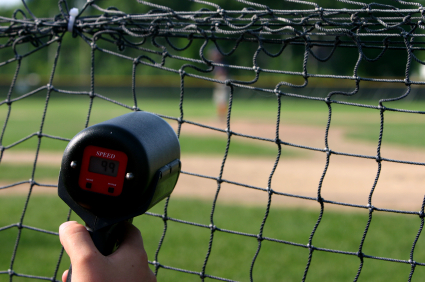While a new study suggests that the harder a youth baseball pitcher throws, the greater may be the risk of elbow injury, particularly to the ulnar collateral ligament (UCL), and that pitch velocity should perhaps be factored into pitch counts in order to protect against injuries, pitch velocity is just one of many factors that increase injury risk.
Elbow injuries can result from a variety of factors:
- improper mechanics
- disruption of the kinetic chain
- lack of strength and flexibility

- inadequate warm-up
- overuse
- injury from falls (i.e. floating bodies/chips); and
- physiological (non mechanical) anomaly
In the genes?
Based on my 25+ years coaching baseball, the last 15+ as a pitching instructor, I believe pitch velocity is actually largely a function of genetics, which determine the size and thickness of tendons and ligaments, and bear little relationsip to the athlete's overall size and appearance. It would be nice to believe that arm joint stabilization may be linked to rotational velocity of the shoulder, so that the faster the joint moves the stronger the integral parts, but the study seems to doubt that relationship. I can't point to any medical research on which to base agreement or disagreement with its findings.
Genetics may explain in part the fact that Nolan Ryan was able to throw fastballs in the mid-90's right until the end of his 27-year baseball career (in fact, the last pitch he threw before blowing out his elbow was clocked at 98 mph), while pitching phenom Stephen Strasberg of the Washington Nationals, who came to the big leagues regularly throwing fastballs in the 98 to 100 mph range, didn't last one full major league season before suffering a torn UCL requiring Tommy John surgery.
In short, pitching speed, in and of itself, doesn't lead to injury, and I cannot foresee any circumstance under which pitch velocity will be regulated in reference to pitch count.
Poor mechanics + pitch speed = injury?
Combine high pitch velocity and poor pitching mechanics, however, and the story has a different ending. There is both clinical and anecdotal evidence that a pitcher's arm is more likely to be injured the faster the arm moves in an incorrect manner. The American Sports Medicine Institute in Birmingham, Alabama, which has done much of the most important research on pitching injuries, has data which indicates that fastballs thrown with poor mechanics are more likely to lead to injury than curve balls thrown incorrectly, a pitch thrown slower and less frequently, and which, at least one study shows, counterintuitively, actually places less stress on the elbow than a fastball when thrown properly. I can attest to that as well from my experience with baseball pitchers over the years. The problem is that there are few coaches who really can "teach" pitching. They merely use (and often abuse) the pitchers that show up.
In addition, while there is no debate in the baseball and scientific communities about the need for pitch limits and rest, the coaches who are supposed to enforce such limits still resist. The reason, unfortunately, is simple: because they would rather win today's game than concern themselves with the well-being of a child two years down the road when the cumulative effect of all those pitches result in injury. They convince themselves it won't happen. We know it does.
Radar guns: teach how to pitch slow, not fast
What about radar guns, which have come in for a lot of criticism lately? (noted orthopedic surgeon, Dr. James Andrews, for one, believes they should be outlawed) The fact is that radar guns are used like resumes or a "calling card": they can get a pitcher into the "interview" or end up getting him cut from the team. Once a player is "hired," a gun is not as important as overall game performance, and, contrary to popular wisdom, radar guns, due to their expense, are used relatively infrequently at the high school level and below, and are employed mostly by college scouts (remember, though, only about 4% of high school players go on to play at the collegiate level).
Better coaching is key to injury prevention
So, in the final analysis, it isn't how fast a pitcher throws as how they are coached. The intellectual intransigence, ignorance and recklessness of coaches will hopefully be mitigated as more evidence is produced in the lab, and parents become better educated. There are plenty of studies that show what is needed to keep kids safe and reduce the risk of injury.
Coaches are charged with a legal duty to meet a standard of care. Ignorance is no defense, negligence is easily documented. Regretfully, change will most likely come from more organizations, insurance entities and coaches being sued. Strict enforcement and litigation may be the only solutions to such reckless disregard of player safety.
John Pinkman is a nationally recognized baseball educator described by Collegiate Baseball Magazine as "one of the top pitching coaches in the country." He is a national columnist, lecturer, and clinician and currently writes and speaks on pitching, the teaching technologies of professional baseball instruction, and baseball school operation. Since 1992 Coach Pinkman has run the Pinkman Baseball Academy (PBA) in Northern Virginia, which operates two indoor baseball academies training students from ages 6 to 66. The academy pitching program is one of the largest in the country, with over 1,000 pitchers.








